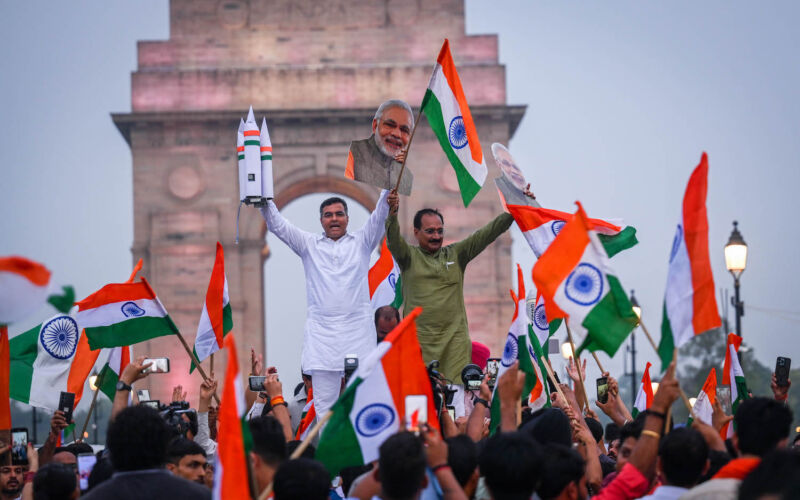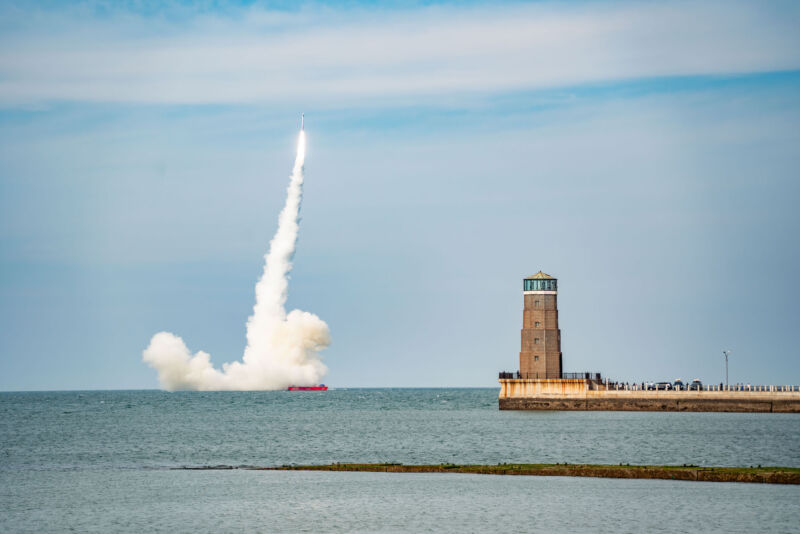Australia-India Screen Ties Strengthen as Migrant Drama ‘Home Before Night’ Heads to Film Bazaar










Enlarge / Parvesh Sahib Singh Verma and Virendra Sachdeva, two members of Narendra Modi's ruling BJP party, celebrate the landing of India's Chandrayaan 3 spacecraft on the Moon on August 23, 2023. (credit: Raj K Raj/Hindustan Times via Getty Images)
All at once, India's government has approved plans to develop a new reusable rocket, the centerpiece of an Indian space station, a robotic sample return mission to the Moon, and a science probe to explore Venus.
"Great news for the space sector!" Indian Prime Minister Narendra Modi posted on X. Collectively, the projects authorized by India's union cabinet will cost an estimated $2.7 billion. Most of the funding will go toward the country's space station and a reusable launch vehicle.
If the projects reach their goals, the approvals announced by Modi on Wednesday will put India on a trajectory to become the third-largest space power in the 2030s, after the United States and China. V. Narayanan, director of India's Liquid Propulsion Systems Center, stated this was the objective in a recent presentation, writing that India's space initiatives will catapult the country to a place "among the three important space powers in the world."

As Asia’s richest man, Mukesh Ambani, addressed his shareholders during a much-anticipated yearly address last Thursday, he also unveiled “JioBrain,” a suite of artificial intelligence (AI) tools and applications that he says will transform a spate of businesses in energy, textiles, telecommunications and more that form his multinational conglomerate, Reliance Industries. “By perfecting JioBrain within Reliance, we will create a powerful AI service platform that we can offer to other enterprises as well,” Ambani said during his speech.
[time-brightcove not-tgx=”true”]The Reliance Chairman’s latest offering comes as India emerges as a crucial player in the global AI ecosystem, boasting a high-powered IT industry worth $250 billion, which serves many of the world’s banks, manufacturers and firms. As the world’s most populous country, India also has a robust workforce population with nearly 5 million programmers at a time when AI talent is in short supply globally, with analysts predicting that India’s AI services could be worth $17 billion by 2027, according to a recent report by Nasscom and BCG.
Puneet Chandok, the President of Microsoft India & South Asia, points to research that finds India has one of the highest AI adoption rates among knowledge workers, with 92% using generative AI at work—significantly higher than the global average of 75%. “These insights highlight the significant impact of AI on the Indian workforce and the proactive steps being taken by both employees and leaders to integrate AI into their daily routines,” Chandok says, adding that the company is also powering initiatives that aim to equip 2 million people with AI skills by 2025.
The spotlight on India comes at a time when many countries around the globe are keen to foster their own competing AI systems rather than turning to the U.S. or China. In the last few years, the Indian government has nurtured an ecosystem where global players like Google and Meta, Indian businesses like Reliance Jio and Tata Consulting Services, and homegrown startups can take advantage of its cost-efficient technological landscape.
India also aspires to have what Rajeev Chandrasekhar, the former Indian Minister for Electronics and Information Technology, calls “sovereign AI,” by integrating large-scale models across sectors like healthcare, agriculture, and governance to drive economic growth. In March, the government ramped up investment worth $1.25 billion towards an ambitious “IndiaAI Mission,” which will aid the development of computing infrastructure, startups and the use of AI applications in the public sector.
“Interestingly, the government itself is the main driver behind India’s AI transformation,” says Jibu Elias, a leading AI researcher and ethicist who helped create IndiaAI. Elias says the push has accelerated since 2020. “We want India to be like a global garage for AI tools, especially for the Global South.”
“The idea is that if you can build tools that address some of the decade-long socio-economic challenges in India, they can be adopted across the globe,” he continues.
It’s a method that Arvind Gupta, who heads the Digital India Foundation in New Delhi, calls a “bottom-up” approach: “Unlike the Googles and Microsofts of the world, India took it to the next level by building trust in technology with digital public infrastructure,” he says. Digital public infrastructure, also known as DPI, is a public-private partnership that was introduced by the government nearly a decade ago by combining technology, governance and civil society. It extends to a biometric identification system, a fast payments system, and consent-based data sharing that now gives India’s 1.4 billion citizens access to public services.
Gupta says DPI is instrumental in giving India an advantage in the global AI race. With 900 million Indians connected to the internet, he points to India being “the data capital of the world,” which has “leapfrogged into the whole culture of artificial intelligence.” That’s because much of this data exists in public data sets that companies can use to write their own AI algorithm. “You won’t see that anywhere else in the world,” Gupta says.

With so much data publicly available, a swath of Indian startups are now racing to build their own large language models or LLMs, which harness generative AI by learning from vast quantities of data. And in a country where people speak more than a dozen languages, “India’s diverse and multilingual environment makes it an ideal test bed for developing and refining global AI solutions,” says Chandok from Microsoft.
In January, Krutrim, an AI startup founded by entrepreneur Bhavish Aggarwal whose name translators to “artificial” in Sanskrit, became India’s first unicorn when it secured $50 million in funding from prominent Silicon Valley investors like Lightspeed Venture Partners and billionaire Vinod Khosla. Similarly, Bengaluru-based startup Sarvam recently launched a voice-enabled AI bot that supports more than 10 Indian languages using open-source software after raising $41 million. The government is also supplementing this innovation by building “targeted LLMs” that can do real-time language translation for citizens accessing public services, Gupta adds.
Still, India’s AI push can’t accelerate without computing power and shared resources. To address this gap, last month, the Indian government finalized the procurement of a thousand graphics processing units, or GPUs, to offer computing capacity to AI makers. Last September, the CEO of chipmaker Nvidia, Jensen Huang, visited India to sit down with Modi and tech executives, setting the company’s sights on the country as a potential location for chip production as the U.S. increasingly clamps down on the export of high-end chips from China. “You have the data, you have the talent,” Huang told Modi at the time. “This is going to be one of the largest AI markets in the world.” This March, the first consignment of Nvidia chips arrived in Indian data centers after the company forged a partnership with Indian cloud services company Yotta, powering its Shakti Cloud as India’s fastest AI supercomputing infrastructure.
Against this backdrop, billionaire-owned Indian companies are eager not to be left behind. In July, India’s largest software company, Tata Consultancy Services (TCS), heavily invested in a generative AI project pipeline exceeding $1.5 billion. Gautam Adani, Asia’s second-richest person, announced a joint venture with UAE in December to explore AI and diversify into digital services.
And as for Ambani, who has urged his employees to accelerate AI transformation across all businesses this year, the goal is clear: “We need to be at the forefront of using data, with AI as an enabler for achieving a quantum jump in productivity and efficiency,” the billionaire told Reliance employees.
Since then, Jio, Reliance’s telecommunications business, has worked with the Indian Institute of Technology to launch “Bharat GPT,” a ChatGPT-style service for Indian users. A video played during a Reliance event demonstrated how the speech-to-text tool would work if successful: a motorcycle mechanic speaks to the AI bot in his native Tamil, a banker uses the tool in Hindi, and a developer in Hyderabad writes computer code in Telegu.
“It’s like the Indian joint family,” said Ganesh Ramakrishnan, the chair of IIT Bombay’s computer science and engineering department. “We are interdependent, and we do better together.”

Enlarge / A sea-borne variant of the commercial Ceres 1 rocket lifts off near the coast of Rizhao, a city of 3 million in China's Shandong province. (credit: VCG via Getty Images)
Welcome to Edition 6.46 of the Rocket Report! It looks like we will be covering the crew test flight of Boeing's Starliner spacecraft and the fourth test flight of SpaceX's giant Starship rocket over the next week. All of this is happening as SpaceX keeps up its cadence of flying multiple Starlink missions per week. The real stars are the Ars copy editors helping make sure our stories don't use the wrong names.
As always, we welcome reader submissions, and if you don't want to miss an issue, please subscribe using the box below (the form will not appear on AMP-enabled versions of the site). Each report will include information on small-, medium-, and heavy-lift rockets as well as a quick look ahead at the next three launches on the calendar.

Another North Korean launch failure. North Korea's latest attempt to launch a rocket with a military reconnaissance satellite ended in failure due to the midair explosion of the rocket during the first-stage flight this week, South Korea's Yonhap News Agency reports. Video captured by the Japanese news organization NHK appears to show the North Korean rocket disappearing in a fireball shortly after liftoff Monday night from a launch pad on the country's northwest coast. North Korean officials acknowledged the launch failure and said the rocket was carrying a small reconnaissance satellite named Malligyong-1-1.